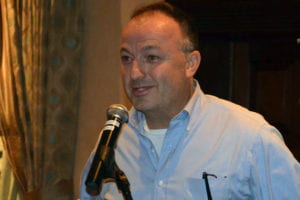By Kevin Redding
Ever since Greg Drossel was young, he’s had a love for the great outdoors. The 64-year-old Ridge resident grew up in Three Villages when it was still a largely wild area and spent most of his days reveling in and examining nature. Whether it was flipping rocks over for in-depth analysis or chasing animals through the woods, Drossel’s upbringing on Long Island laid the foundation for his career as a naturalist, an animal caretaker and, ultimately, the permanent handler of Holtsville Hal, the North Shore’s cherished groundhog and meteorologist, for 21 years.

From 1979 until 1997, Drossel crossed his passion for nature with a desire to get more kids to appreciate the outdoors as general manager of the Long Island Game Farm, a family-owned wildlife park in Manorville that currently features hundreds of animals and has been a frequent destination for school kids for decades. He currently serves as assistant director of student life at Ross School in East Hampton, where he holds lectures and mentors students on all things nature related and started an archery program, for which he is the instructor.
Drossel also served as a consultant for many zoos across the country and was involved in a lot of animal-related confiscation work with the federal government, retrieving illegally kept mountain lions and alligators from people’s homes. The naturalist has even handled animals for films, like Woody Allen’s “Alice” and the 1993 drama “Searching for Bobby Fischer,” and TV commercials and has appeared on “The Today Show” and “Live with Regis and Kathie Lee” with renowned zoologist Jim Fowler.
I had the opportunity to speak with Drossel right before Holtsville Hal made his famous Groundhog Day prediction at the Brookhaven Wildlife and Ecology Center in Holtsville on Feb. 2.
Have you always loved animals?
Absolutely. My dad was brought up on a farm in East Setauket up off Sheep Pasture Road, and I’ve always been around the outdoors, grew up hunting and fishing and camping and having a respect for the natural world and it’s just stuck with me all these years. I hate to use the word, but that’s my drug. My kids say “put dad out in the middle of the woods with a pocketknife and a rock and he’ll be fine for the rest of his life.”
Where did you grow up?
I grew up in the Stony Brook-Setauket-Port Jefferson area and then moved to Lake Grove and now I live in Ridge out in the Pine Barrens.
Did growing up in that area make you the person you are today?
Definitely. Like anything else, I get to go back there quite often because I still have some friends and relatives that still live there. I remember grouse hunting with my dad as a kid where Stony Brook University is now … that was all wild, there was no Nicolls Road [back then]. I remember riding down Nesconset Highway when it was two lanes, one going, one coming, and it’d be nothing to see deer and fox standing on the side of the road in Setauket.
How did you become Hal’s handler?
Just being here. I’ve always enjoyed coming to the Wildlife and Ecology Center. Years ago when I ran the Long Island Game Farm, I used to handle the groundhog Malverne Mel and then when I left the game farm, I was able to spend more time here. This is such a great jewel in the Town of Brookhaven.
Where did Hal come from?
I believe Hal was rescued after being hurt and so that’s why he’s here now. And he’s permanently here [at the Ecology Center.] He’s got his own pen that he lives in.
What’s the life expectancy of a groundhog?
Well, there are understudies and I don’t want to give it all away. Of course, he’s the original Hal and always will be — he’s immortal.
Do you only see Hal on Groundhog Day?
No, I bring my grandkids here a lot and I have a summer camp at the Ross School and twice throughout the six weeks I make a trip out here with a bunch of little five, six and seven-year-olds.
What’s Hal’s personality like?
It depends, we all wake up in the morning in different moods and we’ll find out [today on Groundhog Day] how he’s feeling.
Do you think the little guy enjoys the festivities?
How could he not? I think he does, yeah, but you’d have to ask his agent. I’m just his lowly handler.
Does Hal get any special treats after the Groundhog Day event?
Actually no, he just wants to go back to sleep [like the rest of us], so they bring him back to his pen.
Why do you think it’s important for kids to learn about wild animals and nature?
It’s part of who we are. We all come from nature and we’re all caught up in technology, and I’m not saying that technology is bad but you got to get outside and really appreciate the outdoors. There’s a book called “Last Child in the Woods” by Richard Louv about kids having nature-deficit disorder. You want to learn about geometry? Let a kid look at a pinecone. You want to learn about physics? Let them float a stick down a stream and see where it goes and how it gets there. It’s all out there.






















